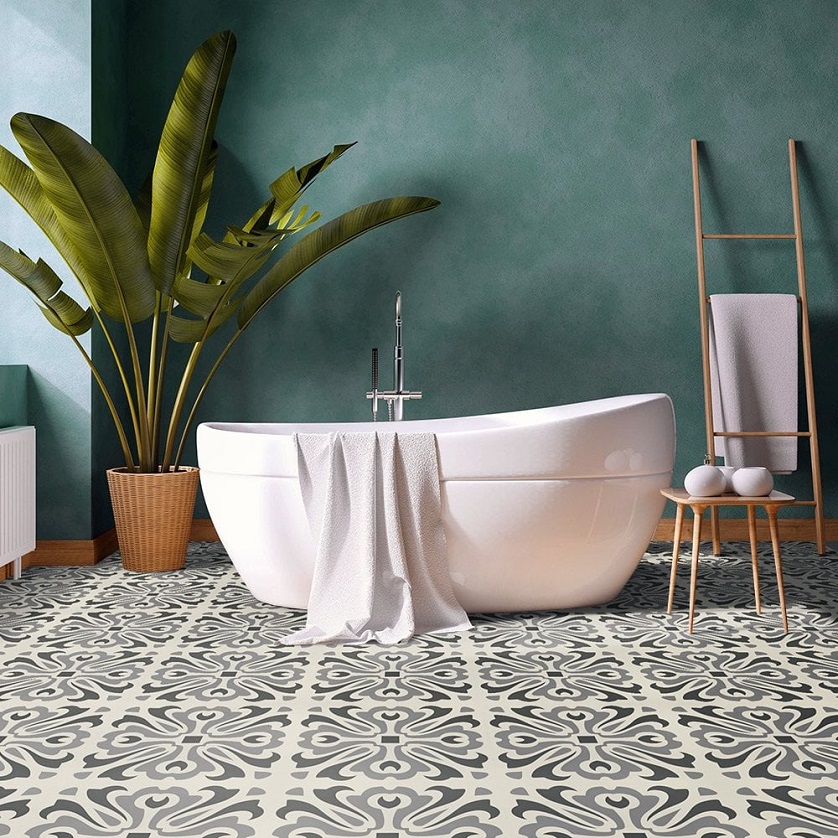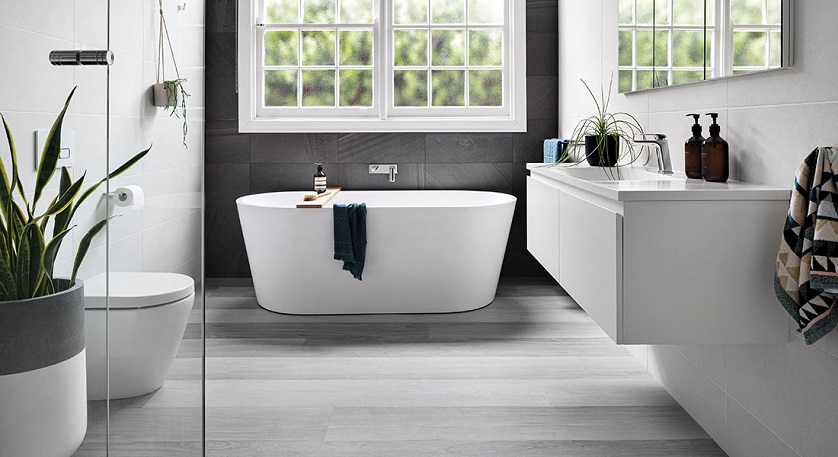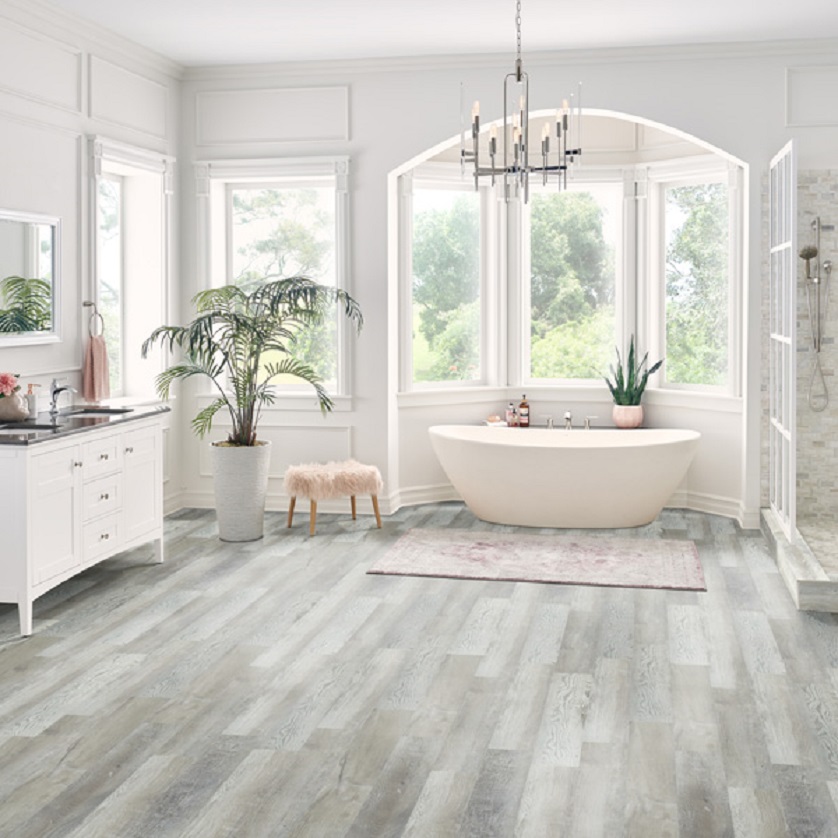When you’re thinking about remodelling your bathroom, you may be tempted to stick with something that’s been done before: white tile or linoleum on the floor. But why not try a different approach? Lately, there has been a lot of talk about vinyl, since vinyl flooring is an available option that just about anyone can take advantage of.
So, if you’re looking for ways to switch up the look in your bathroom while getting all the amenities and benefits of a good floor, you may want to try a vinyl floor bathroom solution. And here are all the benefits you can expect from that.
Contents
Vinyl Is Much Easier to Install Than Ceramic or Stone Tile

Many people have picked a vinyl floor bathroom project over ceramic or stone tile because of the ease of installation, the low cost and the fact that it is resistant. Vinyl floors are much easier to install than ceramic or stone bathroom tile. Because vinyl flooring comes with an adhesive backing, it is simple to cut and install yourself. The adhesive allows you to lay the flooring down without having to adhere to every piece individually.
The first step in installing vinyl flooring is to measure out the room and figure out how much flooring you will need. Make sure you add some extra so that there is enough to cut off when you are finished. You can always return what you don’t use, but it is better to have too much than not enough.
Low-maintenance and Durable
When you buy furniture, you usually tend to strive for low-maintenance materials like teak to save time and money on cleaning, additionally, the same applies to bathroom floors and for that reason, vinyl flooring is your best choice. Vinyl doesn’t require a lot of maintenance, which makes it easy to keep clean and you won’t have to worry about scratches and stains showing up over time. Vinyl flooring has a lifespan that can reach up to even 50 years, so you won’t need to worry about replacing it any time soon.
Vinyl bathroom floors are also waterproof. While many flooring solutions claim to be water-resistant, vinyl is truly waterproof, making it perfect for use in all rooms, particularly kitchens and bathrooms. Vinyl can survive wetness, heavy foot traffic, scratches, and spills because of its numerous layers, which include a strong wear layer and solid core.
There Are Many Styles and Colours to Choose From

In regards to looks, there are two different kinds of vinyl floors; solid colour and patterned. The solid coloured variety has only one colour throughout the entire roll of flooring. Patterned vinyl has several different colours throughout each roll of vinyl, which gives a more realistic wood look. When picking the right colour for your floor, the best thing to do is choose one that looks the most suitable with the rest of the design and is a close enough match to your walls or vanity.
It Can Resemble Wood or Stone
Vinyl bathroom flooring can help you achieve the look you want for your bathroom because it can be made to resemble wood or stone. This gives you more options for the design of your bath space, so, if you want all the benefits of a low-maintenance floor, but still want the look of a wood or a stone, then vinyl bathroom flooring is a good choice.
Luxury vinyl tile, for example, has the appearance of genuine stone flooring, which has been faithfully replicated using advanced digital print technology and embossing techniques. Luxury vinyl plank, or LVP, on the other hand, is the vinyl flooring that most closely resembles wood. Luxury vinyl is often of high quality and produces pleasing visual effects.
How to Keep Your Vinyl Floor in Top Shape

Since you probably want your flooring to last for many years, it is important to know how to properly care for vinyl floors in your bathroom.
Sweep and Vacuum Regularly
Sweeping and vacuuming on a regular basis removes dirt and debris from the surface of the vinyl tiles before they have a chance to get ground in. Dirt left on the floor can scratch the surface over time, causing damage that will be noticeable much quicker than if you keep up with sweeping regularly. You can use a broom with stiff bristles or a vacuum cleaner with a hose attachment when cleaning the vinyl floors in your bathroom. After sweeping, mop up any residue left behind with a damp mop, rinsing it occasionally.
Wipe Up Spills Immediately
Even though vinyl can stand up to moisture, leaving liquids to pool on the surface for an extended period of time is never a good idea. Blot up any spills immediately, then clean the area with a damp sponge or mop and mild detergent. The floor should then be rinsed with clear water to remove any residue from the cleaning product.
Be Consistent
If your bathroom has a lot of natural light, you’ll need to clean your vinyl floors more often. The sun’s ultraviolet rays can cause discolouration over time, so limit sunlight into the room by closing blinds when you aren’t using the bathroom.
Keep Yourself Safe While Cleaning
Make sure the bathroom is well-ventilated with fans or even open windows when you’re cleaning or applying products. This will help dissipate harmful fumes from chemicals, that might harm your lungs or cause long-term damage to your sinuses if you breathe them in.
To Sum Up
Vinyl has changed the home flooring industry. These floors are easy to install, maintenance-free and they come in a variety of different colours. Although vinyl has been around for years, there seems to be a surge in the use of vinyl floors in bathrooms. If you’re looking for a way to elevate your bathroom and give it something extra, then investing in vinyl flooring is a great choice. It will breathe new life into your bathroom and add that extra touch that sets it apart from what others have in their showers and stalls.











